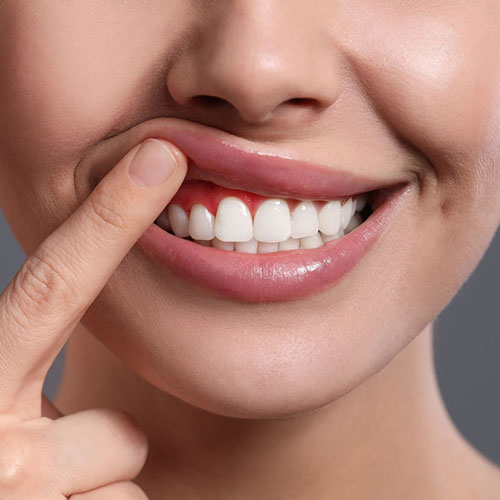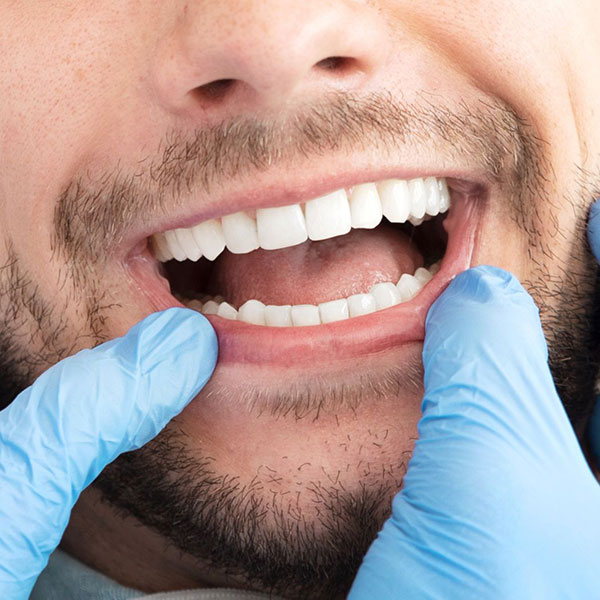Gum Disease
Understanding Gum Disease: An Overview
Half of all adults in America have periodontal disease, also known as gum disease. This chronic infection causes catastrophic bone loss that results in unstable and, ultimately, lost teeth. It is primarily caused by the buildup of plaque, a sticky film of bacteria that forms on your teeth. If not adequately removed through daily brushing and flossing, plaque can harden into tartar, leading to inflammation of the gum tissues, known as gingivitis. Without treatment, gingivitis can progress to periodontitis, a more severe form of gum disease that can damage the soft tissue and bone, potentially leading to tooth loss.
The Importance of Early Detection
Early detection and treatment are crucial in managing gum disease effectively. In its initial stages, gum disease is easier to treat and can often be reversed with proper dental care and improved oral hygiene practices. Regular dental check-ups play a vital role in identifying gum disease early on, allowing for timely intervention and preventing further progression.
Loudoun Periodontics is proud to provide minimally invasive procedures for patients with gum disease. We have the tools and resources to effectively stop bone loss progression and often regenerate lost bone, including the PerioLase, the only laser FDA-approved for true regeneration of lost bone.
Warning Signs of Gum Disease
You may not even be aware you have gum disease because periodontal disease is a silent process and rarely causes pain. However, if you are experiencing any of the following warning signs, Loudoun Periodontics can help.
- Bleeding gums while brushing
- Red, swollen or tender gums
- Constant bad breath
- Gums that have pulled away from the teeth
- Loose or separating teeth
Key Benefits of Gum Disease Treatment
Choosing the right treatment for gum disease can significantly impact your overall health and well-being. The health risks of gum disease go far beyond the loss of teeth.
Here are the key benefits of our comprehensive treatment approach:
- Prevents Progression of Gum Disease: Early intervention halts the disease’s advancement, protecting your gums and teeth from further damage.
- Improves Oral Health: Our treatments are designed to eliminate bacteria, reducing inflammation and bleeding of the gums.
- Enhances Overall Health: There is a connection between gum disease and a number of serious medical conditions. People with periodontal disease are almost twice as likely to suffer from coronary artery disease, and have nearly twice the risk of having a fatal heart attack. Gum disease has also been linked to other health problems, including respiratory disease, diabetes, Alzheimer’s, certain cancers, heart disease, stroke, osteoporosis, erectile dysfunction, HPV, and pregnancy complications.
- Reduces Tooth Loss Risk: By addressing gum disease promptly, we can help preserve your natural teeth, maintaining your smile and bite function.
- Boosts Confidence: Healthy gums improve your smile’s appearance, boosting your confidence and quality of life.
What is Periodontal Disease?
Periodontal disease is an infection of the structures surrounding your teeth, including your gums and jawbone. Bacteria found in dental plaque is the main cause of periodontal disease, while smoking, misaligned teeth, grinding or clenching of teeth, stress, and certain medications are also factors that contribute to this disease.
What is Gum Disease?
Gum disease begins when plaque accumulates on the teeth and hardens into tartar or calculus. Certain types of germs that live in this plaque and calculus damage gum tissue. Your body tries to fight this infection with an inflammatory attack. This inflammation causes the tissue to bleed easily when you brush or floss. This stage of the condition is called gingivitis. If the infection and inflammation persist, the result is a chronic inflammatory condition that destroys gums and bone around the teeth. At this stage, it is called periodontitis. Often there are no symptoms at all.
What can I do to prevent gum disease?
Make sure you see your dentist regularly so any periodontal disease can be diagnosed. Remember, periodontal disease doesn’t hurt, so you won’t even know you have it until it is too late! Once the disease is diagnosed and you are sent to a periodontist, it is important to complete any recommended treatment and then begin a specific recall schedule for cleanings. This is critical to maintain control of the disease so you can keep your teeth for a lifetime.
Habits that will help to prevent gum disease include:
- Brush at least twice a day for 2-3 minutes, ideally with an electric toothbrush
- Floss daily to remove plaque from hard to reach places
- Avoid tobacco use
- Eat a balanced diet
- Exercise preventative care and schedule regular dental cleanings
- Be aware that certain medications can contribute to gum disease
How do I know if I have gum disease?
- Your gums are red, swollen, and bleed easily
- Your gums that seem to have pulled away from the teeth
- You have noticed bad breath
- You see or taste pus between your teeth and gums
- Your teeth may be loose or moving away from one another
- You feel a change in the way your teeth fit together
- Or, most commonly, you may feel no symptoms at all!
The Evaluation Stage

Diagnosing Gum Disease
Our comprehensive evaluation process is the first step in your treatment plan. During your initial visit, our dental team will conduct a thorough examination of your gums, teeth, and overall oral health. This evaluation includes:
- Periodontal Charting: We measure the depth of the spaces between your gums and teeth, known as periodontal pockets. Shallow pockets are normal, but deeper pockets may indicate gum disease.
- X-Rays: To assess any bone loss around your teeth, which is a sign of advanced gum disease.
- Oral Examination: Checking for signs of plaque and tartar buildup, gum inflammation, and any other oral health issues.
This detailed assessment helps us determine the extent of the gum disease and tailor a treatment plan that best suits your needs.
The Treatment Process
Treating Gum Disease: Our Approach
Treatment for gum disease varies depending on the severity of the condition. Our goal is to control the infection, halt the progression of the disease, and restore the health of your gums and teeth. Treatment options may include:
- Scaling and Root Planing: This deep-cleaning, non-surgical procedure involves removing plaque and tartar from above and below the gum line and smoothing the rough spots on tooth roots where bacteria gather.
- Medications: In some cases, antibiotics or antimicrobial mouth rinses may be prescribed to help control bacterial infection.
- Laser Treatment: Advanced cases of gum disease may benefit from laser therapy, which targets and removes diseased tissue while promoting regeneration of healthy gums.
- Surgical Treatments: For more severe cases, surgical options such as flap surgery or bone and tissue grafts may be necessary to repair damaged tissues and bone.
Why Should I treat Gum Disease?
The easy answer is because you want to keep your teeth. However, the health risks of gum disease go far beyond the loss of teeth. There is a connection between gum disease and a number of serious medical conditions. People with periodontal disease are almost twice as likely to suffer from coronary artery disease, and have nearly twice the risk of having a fatal heart attack. Gum disease has also been linked to other health problems, including respiratory disease, diabetes, Alzheimer’s, certain cancers, heart disease, stroke, osteoporosis, erectile dysfunction, HPV, and pregnancy complications.
Recovery and Aftercare

Recovery from gum disease treatment varies depending on the type of procedure performed and the severity of the disease. After treatment, it is common to experience some sensitivity and swelling, which typically subsides within a few days. We will provide you with detailed aftercare instructions to ensure a smooth and speedy recovery. Key components of aftercare include:
Oral Hygiene: Maintaining optimal oral hygiene is crucial for healing and preventing the recurrence of gum disease. We recommend gentle brushing with a soft-bristled brush and flossing daily.
Follow-Up Visits: Regular follow-up appointments allow us to monitor your recovery and ensure that your gums are healing properly.
Lifestyle Adjustments: We may suggest lifestyle changes, such as quitting smoking or improving your diet, to support your oral health.
Commitment to Your Oral Health: Our team is dedicated to supporting you through every phase of your treatment and recovery. We believe in the power of education and will provide you with the knowledge and tools you need to maintain healthy gums and teeth for life.
Thank you for choosing us as your partner in oral health. Together, we can achieve a healthier, brighter smile.
